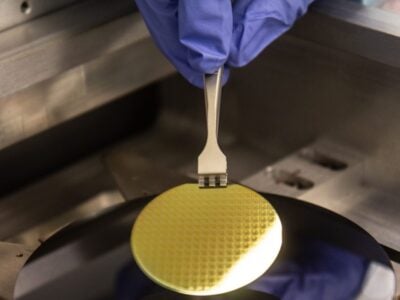
Nanotube-based NRAMs taking over the world soon, says Nantero
Back in July 2000, the paper was laying the foundations for a bistable non-volatile RAM cell to be designed with a suspended Single Wall Carbon Nano Tubes (SWCNTs) crossbar array, switchable into well-defined Off and On states. The device being designed in such a way that each state represent a potential energy minimum (a balance between elastic energy in the Off state and the van der Waals energy in the On state), switched by charging the nanotubes to produce attractive or repulsive electrostatic forces.

In his paper describing the 1 transistor SWNT NRAM cell, Rueckes had established possible switching speeds up to 100GHz for a 20nm device, extrapolating this to 200GHz operation for a cell designed at the 5nm node (owing to the smaller effective mass of the moving CNTs). Other claims are that the NRAM operates at orders of magnitude more cycles than flash (over 1011 of program endurance) and retains memory for over 10 years at 300ºC (could be over a thousand years at 85ºC)
Since then, the startup has secured an extensive patent portfolio (175+ US patents issued and over 200 patent applications pending, including internationally) and boasts a dozen high profile customers lining up to license its IP.
The company expects both foundries and OEMs to license the IP, for some to embed the CMOS-compatible NRAM within chip designs, and for others to produce DDR4-compatible multi-GByte arrays as pure memory chips.
“We want to be the ARM of the memory business”, said Greg Schmergel, Nantero’s CEO and other Co-founder in an interview with EETimes Europe.
For practical manufacturing purposes and because today no lithographic equipment would reach the 2nm level of precision equivalent to a CNT’s diameter, the actual switches do not rely on single CNTs but rather on a random mesh of hundreds of CNTs with many different intersection points, explained the CEO.
“Lithography is our main limiting factor, we deposit the carbon nanotubes through a spin coating process before patterning the switches, so our technology can scale pretty much as far as lithography can go” he said.
“For now, we see most design efforts around the 2x nm node, typically 28nm, and our customers achieve densities higher than DRAM” Schmergel said, hinting that the first product tape-outs were due for the end of the year.
“We wanted to design 15nm prototypes, but we couldn’t access any lithographic equipment with resolutions below 15nm” he added, reminding us that the initial claims of the paper were that the NRAM cells could in theory be built with as few as two nanotubes.
On the upside of having random bundles of carbon nanotubes acting as bulk switches is the fact that the same NRAM device could be run either as a single-level memory (one bit per switch) or on multi-levels (several bits per switch) providing the appropriate encoding schemes are used.
“It would essentially be the same structure, you would not need to re-engineer the device to move to a multi-level memory device”, confirmed Schmergel, adding that for the next few years, the company would focus on single-level memory devices.
So how cost-competitive will these devices be?
“For embedded memory, we have a cost advantage because we use less power than embedded flash, there is also less overhead circuitry and our process only requires one or two mask layers versus many masks for flash” Schmergel says.
The CEO expects NRAM to compete with standalone DRAM in the near term, while it could take longer to beat flash on cost alone. But as customers move to smaller nodes and ramp up their production, then CNT-based memory could end up consolidating the memory marketing, eventually replacing multiple memory chips into one fast nonvolatile memory chip.
The bi-stable CNT switches could also be used as configurable logic tables, Nantero also has IP for sensors, interconnects and loss-less transistors, but is not actively commercializing it for now.
Related articles:
NRAM’s time is here, says startup Nantero
Imec and Nantero launch joint carbon nanotube memory program
 If you enjoyed this article, you will like the following ones: don't miss them by subscribing to :
eeNews on Google News
If you enjoyed this article, you will like the following ones: don't miss them by subscribing to :
eeNews on Google News



